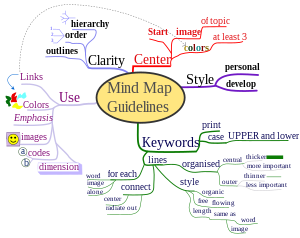Executive Summary
For most clients and planners, the data gathering process is simply viewed as a necessary evil to obtain the information required to produce a financial plan. The planner proceeds through a long list of questions, covering everything from financial details to client goals and aspirations, recording it on a data form or notepad to be used later. A new approach is emerging, though - to complete the data gathering process using mind mapping, which organizes information visually, in a manner that both the planner and client can build upon. The end result is a data gathering meeting that is more collaborative and interactive, as clients become part of the process of building a mind map that takes shape before their eyes - and also becomes an actual takeaway from the meeting, as the mind map document itself is provided in print or electronically to the client as well. Which means in the end, mind mapping may be a way to improve the financial planning experience itself.
The inspiration for today's blog post is a recent conversation I had with financial planner Rob O'Dell of Wheaton Wealth Partners. Rob is a proponent of using Mind Mapping software to facilitate the data gathering process. Except as Rob noted, it has been so successful from the client's perspective, he has actually received referrals for people who also want to go through the process - a stark contrast from the experience of most financial planners!
What Is Mind Mapping?
 Created by British psychologist Tony Buzan, mind mapping is a graphic method of taking notes and capturing information, where a central idea expands outward into branches, and then further detail is added from there.
Created by British psychologist Tony Buzan, mind mapping is a graphic method of taking notes and capturing information, where a central idea expands outward into branches, and then further detail is added from there.
Contrasted with the traditional, "linear" approach to note taking, using a mind map relies more on associative thinking and the connections our brains naturally make in jumping from one concept to another. As a result, mind mapping is often considered an effective tool for brainstorming. The image to the right (from the "Mind Map" entry of Wikipedia) represents an example of a mind map - showing the guidelines of mind mapping.
The video below, by Gary Klaben (a financial planner who trains other planners how to use and apply mind maps in their practice), shows a basic example of how a grocery list exists as a traditional list of things to purchase, and how it would be organized as a mind map - where items to buy are associated with the aisles where they would be found, and grouped accordingly. Notably, often our brains are already converting lists into a more associative framework (read through a grocery list at the store, and you're probably already visualizing what's found in which aisle) - arguably, the mind map simply crystallizes the process.
Mind Maps In Financial Planning
So how might mind mapping work in the financial planning context? Instead of mind mapping the aisles of a grocery store and what you plan to purchase, imagine instead that the major branches of the mind map tie to the data gathering process. One branch might be labeled Family, another Assets and Liabilities, another Goals, and another Other Professionals. Instead of filling out the blanks on a data sheet in a linear fashion, the branches of the mind map are filled out with client information.
A key distinction, though, is that mind mapping a client data gathering meeting isn't just about a different way to organize the information for the planner; it's about organizing the data for the client as well. Accordingly, the mind map isn't just something for the planner to use to take notes; O'Dell puts the mind map up on a big television screen in his conference room, and he and the clients work through it together.
The Benefits Of Mind Mapping
What's significant to me about mind mapping in the financial planning context is that, as a result, the data gathering meeting shifts from a one-sided interview process, into a more interactive and collaborative financial planning experience. Clients aren't just answering the planner's questions. Instead, they're working together to build something that takes shape before their eyes. Thus, while I know some financial planners already use mind mapping to organize their own thoughts, the key distinction to me is having it up on the television screen for the client to see, participate, and engage as well.
From the client's perspective, the experience is also rewarding because they're building something that ultimately is for the planner and themselves - as O'Dell makes sure that the completed mind map is emailed out to the client at the end of the meeting so it's waiting in the inbox when they get home or back to their own office. Thus, the mind map becomes a useful reference sheet for the client, too - quite literally, making their understanding of their financial life more organized. It's the difference between saying we make our client's finances more organized, and actually making them more organized.
If you're looking to try it out yourself, O'Dell recommends MindGenius (30-day free trial available). You might also check out Gary Klaben's workshops, webinars, and other training services at Protinus on how to integrate mind mapping into your practice.
So what do you think? Have you ever used mind mapping yourself? Have you ever gone through a mind mapping process with a client? Do you think it would make the financial planning experience more collaborative and engaging for the client?





for those who are interested, check out the work being done by CEG Worldwide. Great stuff.
I read books about mind mapping long back. Learnt to mind map last year and have since been using it for my own strategic planning. Never thought of using it for data gathering or for that matter any aspect of Financial Planning. It could possibly used for Plan presentation too.
Thanks a ton Michael for sharing this.
I find mind mapping hugely valuable. mostly in getting all the ideas out on the table without too much organization. The limited structure and visual nature help me make sure I haven’t forgotten anything. I used them extensively in writing my about-to-be-published book, making a map for each chapter. I had not thought of using it in the data collection but it is a great idea. I will start trying it.
I’ve been a fan of mind mapping for years but I have not found any software that replaces the free form of using pencil. A huge benefit of mind mapping is that you get everything on a page that is easy to follow.
Great idea. I find mind-mapping to be holistically organizational, so that in addition to interactive, I would see potential for lfe planning and THEN help with financial realizatiion
Actually mind mapping was used years before in the Evelyn Wood Reading Dynamics courses (custom tailored to college students in the early ’70’s as well as in the Art of Writing by Rico (1983 Tharcher)The point is association is a better first run through then one can assemble in a linear fashion… Use a tree of key effectiveness areas (i.e. Asset Protection, Asset Accumulation, Income Conservation, Asset Conservation – and branch thereafter with a client… is a useful exercise – making the fact finding visual… Then in a separate meeting distill down from the picture linearly to fill in the twigs…
PS I organized my two editons of Enough initially with this process as well as my other books (Trust Me. I’m Not A Veterinarian)
Add a chronological line thereafter to see patterns relative to decisions, turning points, regrets etc – derived from the first ‘mind map’
I actually started doing this with pro-bono clients since I needed to get a lot of information in something they could take with them at the end of the meeting. It’s been really well received, and I’ve started doing it with all clients and all meetings (except for the 3 Questions discussion). I keep a separate node for “Action Items” and add them as we go through the conversation and we work off of that list.
Been using Mindjet for years. Was pleased to see some of the Financial Planning students use mindmapping as part of the written financial plans they submitted for the upcoming FPA financial planning challenge.
If you want to create a mind map without the visual map, one go-to app is Workflowy.
It’s very easy to add topics, indent sub-topics, drag and drop topics to new areas, and collapse and expand entries to view as much or as little as you want.
http://fppad.com/2012/04/27/how-financial-advisers-can-improve-their-personal-workflow/
I LOVE mind mapping.
Mind mapping is also an amazing tool for writers so your readers who adopt it for data-gathering meetings should consider it for that purpose, too.